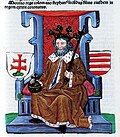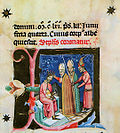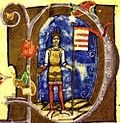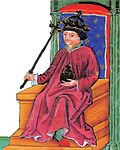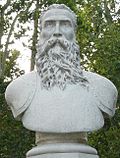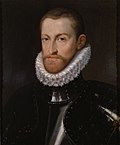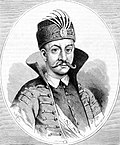| Portrait | Name
(Birth–Death) | Term start | Term end | Notes | Monarch
(Reign) |
|---|
 | Levin Rauch
(1819–1890) | 27 June 1867 | 26 January 1871 | Member of the Unionist Party that advocated for more integration of Croatia into Hungary. Notable for securing victory of the Unionist Party through changing the election law and terrorising those who were able to vote. [18] | Franz Joseph I

(1848–1916) |
 | Koloman Bedeković
(1818–1889) | 26 January 1871 | 12 February 1872 | Bedeković was the leader of the Unionist Party and fought against Croatia's autonomy from Hungary. Dissatisfaction with the obstruction of parliament led to the Rakovica Revolt. Early elections were subsequently called for in 1872. The failure of Bedeković to convene the previous parliament resulted in him being removed from the post of ban and replaced with the first non-noble ban, Ivan Mažuranić. |
 | Antun Vakanović
(1808–1894) | 17 February 1872 | 20 September 1873 | Acting ban |
 | Ivan Mažuranić
(1814–1890) | 20 September 1873 | 21 February 1880 | Mažuranić was the first Croatian ban not to hail from old nobility, as he was born a commoner. He was a member of the People's Party. He accomplished the transition of Croatian lands from a semi-feudal legal and economic system to a modern civil society similar to those emerging in other countries in Central Europe. |
 | Ladislav Pejačević
(1824–1901) | 21 February 1880 | 4 September 1883 | As the reincorporation of the Military Frontier into the Kingdom of Croatia-Slavonia was proclaimed on 15 July 1881, Pejačević was given the task to follow it through. On 1 August 1881, he took over the administration of the former Frontier. On 24 August 1883, he quit after the Council of Ministers in Vienna concluded that bilingual Hungarian official emblems, installed by Hungarian officials in Croatia-Slavonia, were not allowed to be removed from the official buildings and were to stay along the Croatian ones. |
| Hermann Ramberg
(1820–1899) | 4 September 1883 | 1 December 1883 | Acting ban |
 | Karoly Khuen-Héderváry
(1849–1918) | 4 December 1883 | 27 June 1903 | Khuen's reign was marked by strong Magyarization. After a series of riots broke out against him in 1903, Khuen was relieved of his duty and appointed prime minister of Hungary. |
 | Teodor Pejačević
(1855–1928) | 1 July 1903 | 26 June 1907 | At the beginning of the 20th century, he was faced with a new direction of Croatian policy marked by political alliance between Croats and Serbs in Austria-Hungary for mutual benefit. A Croat-Serb Coalition was formed in 1905, and it governed the Croatian lands from 1906 until the dissolution of the Dual Monarchy in 1918. As Pejačević supported the ruling Coalition in its resistance towards the Hungarian request in 1907 to make the Hungarian language an official language on railways in Croatia, he was forced to resign. |
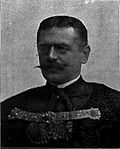 | Aleksandar Rakodczaj
(1848–1924) | 26 June 1907 | 8 January 1908 | |
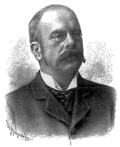 | Pavao Rauch
(1865–1933) | 8 January 1908 | 5 February 1910 | From the very beginning of Rauch's rule, the Croato-Serbian Coalition announced that it would refuse to co-operate in any manner with the new unionist ban. [19] After the Croatian Parliament had been disbanded on 12 March 1908, because of its refusal to co-operate and the insults it directed at the ban, Pavao Rauch ruled through decrees and civil servants. Despite all opposition predictions, Rauch remained in power for two years. On 5 February 1910, he received the king's letter of dismissal. |
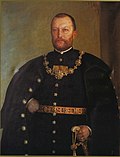 | Nikola Tomašić
(1864–1918) | 5 February 1910 | 19 January 1912 |
 | Slavko Cuvaj
(1851–1931) | 19 January 1912 | 21 July 1913 | He was appointed in January 1912, when anti-Habsburg sentiments were on the rise in Croatia, often manifesting in sympathies for Serbia and calls for creation of a Yugoslav state. Cuvaj tried to curb those trends by series of decrees directed at curbing the freedom of the press, limiting rights of assembly and local autonomy. This created a backlash in the form of strikes and demonstrations. Some young radicals even engaged in terrorism. Cuvaj himself was target of two assassination attempts in 1912. |
 | Ivan Skerlecz
(1873–1951) | 27 November 1913 | 29 June 1917 | Skerlecz managed to reconvene the Croatian Parliament in Zagreb by 1915. The Croats made further demands for local authority, as well as unification of Croatia-Slavonia with Dalmatia and Bosnia and Herzegovina. |
Charles IV
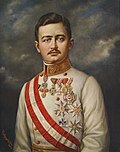
(1916–1919) |
 | Antun Mihalović
(1868–1949) | 29 June 1917 | 20 January 1919 | |



